The National Biodiversity Strategy and Action Plan (NBSAP) outlines five strategies and respective action plans that work towards achieving the three CBD objectives.
These five strategies aim to encapsulate the objectives and work of CBD, NParks and other stakeholders:
Strategy 5: Strengthen Partnerships with All Stakeholders and Promote International Collaboration
This strategy aims at conserving Singapore's habitats and ecosystems for long-term sustainability so that Singaporeans can benefit from their multiple functions. Concerted efforts should be made to protect existing native species, habitats and ecosystems, and to re-establish species that once existed.
Many programmes are being carried out in Singapore, designed to conserve and recover native species. Current initiatives include bird, dragonfly and plant conservation. In particular, Singapore's conservation work with Oriental Pied Hornbills has received national and international attention and such work is now being extended to other species. With regard to plants, we conserve rare species in their natural habitats, rescue plants from areas undergoing development; and increase their numbers through seed planting, cuttings and tissue culture, keeping them in secure areas for protection.
We established the Yishun Arboretum in 2008 for the ex-situ conservation of rare dipterocarp trees, and will continue with other tree conservation projects in different parks.
Dragonflies are important indicators of freshwater habitat quality. The 117 species found locally are being cultivated by enhancing water bodies such as ponds and streams with plants important for dragonflies. The designs of parks such as Jurong Central Park, Admiralty Park and Gardens by the Bay are also being improved to enhance dragonfly habitats. All these initiatives improve the experience of park visitors, who can enjoy better surroundings and lively, colourful insects.
NParks also creates and enhances habitats by replanting degraded areas, developing new grasslands for birds and improving mangroves. These activities are carried out in conjunction with other agencies, in many parts of Singapore, so that sufficient habitat is available for the species we are striving to conserve.
Coral reefs in Singapore, though small in size, boast a relatively high biodiversity. These reefs are however, threatened by various human activities. In order to enhance and restore the current coral cover in Singapore, a coral nursery was established off Pulau Semakau in 2007. Unlike other commercial methods of harvesting corals, which breaks up healthy coral colonies for planting, the Pulau Semakau nursery is the first coral nursery in the region that uses “coral of opportunity” (i.e. coral fragments that lie free on the reef having been fragmented by some impact) as seed corals for growth and transplantation.
This is akin to a horticultural nursery providing seedlings to be planted in forest sites that need to be reforested. Coral fragments that have been successfully grown in the coral nursery are being transplanted onto the degraded reef sites off the southern coast of Singapore.
The National Parks Board and National University of Singapore jointly champion this marine conservation project with sponsorship from Keppel Corporation and support from the National Environment Agency.
NParks is also creating and enhancing habitats by replanting degraded areas, developing new grasslands for birds, and improving mangroves. These activities are carried out in many parts of Singapore in conjunction with other agencies so that sufficient habitat is available for the species we are striving to conserve.
Terrestrial Rehabilitation Programme: Ketam Mountain Bike Park
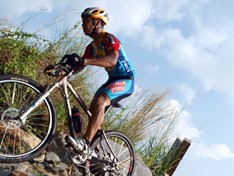
The Ketam Mountain Bike Park in Pulau Ubin is a good example of how land can be optimally used for different needs. The project demonstrated the sustainable co-existence of nature conservation and outdoor recreation.
When NParks took over management of the site in 1999, it had been highly impacted by past granite quarrying activities. The severely degraded park was devoid of greenery and biodiversity, and the ground was highly compacted with granite chips and dust.
To rehabilitate the site, about 350,000 cubic metres of soil was brought in for landscaping and over 1,500 trees and shrubs were planted. The Bike Park is now a lush habitat for a large number of open country wildlife, even attracting birds previously not found in Pulau Ubin such as the Red-wattled Lapwing, Baya Weaver and Lanceolated Warbler.
Active, Beautiful and Clean (ABC) Waters Programme

The soft-scaping of our waterways has an important role to play in benefiting our biodiversity. Most streams, rivers and ponds in the built-up parts of Singapore had been given hard edges, created by masonry, walls or concrete, to prevent flooding and protect infrastructure. Now, the trend has been reversed: changes in water flow and water levels are managed rather than prevented, and the ABC Waters Programme engages the People, Public and Private (3P) sectors to take ownership of water resources. It includes initiatives to manage catchments and waterways for recreation and enjoyment. Our drains, canals and reservoirs are now being transformed into beautiful streams, flowing rivers and vibrant lakes through the ABC Waters Programme.
Soft edges, with a variety of native plants, help to merge the man-made and the natural environments together. They encourage direct interaction between people and the waterways. Projects such as the revitalisation of the Kolam Ayer riverside encourage dragonflies, kingfishers and local water plants to thrive. Planted edges create more habitat types, and more places for animals to seek shelter, rest and feed. The plants can also help in making the water cleaner.
More information about the ABC Waters Programme can be found at http://www.pub.gov.sg/abcwaters/
Strategy 2: Consider biodiversity issues in policy and decision-making
This strategy aims to conserve Singapore's habitats and ecosystems for long-term sustainability so that Singaporeans can benefit from their multiple functions. Concerted efforts should be made to protect existing native species, habitats and ecosystems, and to re-establish species that once existed.
Actions:
- Incorporate biodiversity conservation considerations that include integrating coastal management principles into existing administrative processes
- Enhance biodiversity assessment capabilities
- Strengthen the current processes on access and benefit sharing, to ensure that biodiversity conservation is considered when granting access to Singapore’s natural genetic resources
Integrated Coastal Management
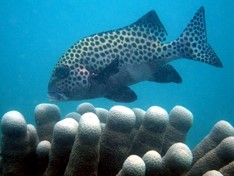
As Singapore progresses economically, the multi-sectoral use of Singapore's coastal and sea-space resources becomes increasingly more complex, requiring the balancing of development, navigation, public health and conservation goals. The Technical Committee on Coastal and Marine Environment, comprising members from different agencies with a stake in the marine environment, was set up to address these issues, and will adopt integrated coastal management principles as a holistic approach in managing our coastal and marine resources.
Saving Chek Jawa
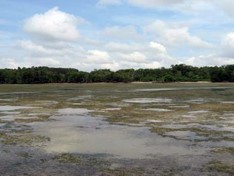
Do Singaporeans care about our biodiversity? In 2001, the public learnt about the rich biodiversity of Chek Jawa. Many people visited the unique juxtaposition of at least five inter-tidal ecosystems that are found in the area. Visitors of all ages were fascinated by the various organisms seen only during the low tides that occur during the early or late hours of the day. Even more flocked to experience Chek Jawa when they learnt that it was slated for reclamation. There was an initial sense of resignation with regard to the possible loss of Chek Jawa’s natural beauty due to the planned reclamation. However, many felt so strongly about the natural heritage of Chek Jawa that they appealed to the Government to seek alternative solutions.
Did the Singapore Government take biodiversity into consideration during its decision-making and listen to citizens’ feedback? After studying the numerous appeals, supported by documentation of the unique biodiversity found in Chek Jawa and views of the scientific experts, the Government decided that as long as the area was not needed for development, Chek Jawa would be kept in its natural state.
Today, Chek Jawa, a jewel of our natural heritage, continues to be as popular as ever and enjoyed by all who visit.
Strategy 3: Improve knowledge of our biodiversity and the natural environment
Keen knowledge of how the key ecosystems respond to our activities will enable us to conserve and use them in a sustainable manner. It is essential that we support taxonomic studies, document our biodiversity and conduct ecological research.
Actions:
- Encourage and facilitate research, in particular on ecosystem and species-specific biodiversity conservation, the interactions between the biological components and their physical environment, biodiversity valuation studies and the impact of climate change on biodiversity
- Monitor the health of ecosystems and species as part of the management process
- Develop and maintain a central information portal on biodiversity to facilitate more informed decision-making
- Maintain a list of species with their conservation status (red data list)
- Compile case studies on and assess best practices that have been implemented
Singapore Red Data Book
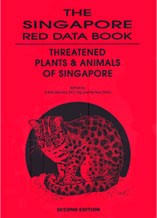
The Red Data Book is a list, with photographs and descriptions, of the plant and animal species in Singapore that need their conservation status raised. The Book indicates the main reasons for rarity of these species and gives positive guidance on actions that can be taken to improve their situation. Many countries have their own Red Data Book, complementing the global list of threatened species that is maintained by IUCN World Conservation Union. Singapore's first edition of the Red Data Book was produced in 1994 and a second updated edition was published in 2008.
The book is a resource for planners, researchers, students and agencies to help plan conservation actions. It is also the basis for monitoring so that the status of species can be tracked. Its contents highlight a number of cases where the status of a species in Singapore differs from the global picture. A species that is common overseas can be very rare in Singapore. Conversely, some species threatened elsewhere, such as the Great-billed Heron and the Straw-headed Bulbul, are doing well here. Local context is very important in planning local actions. This is where Singapore's own data sources and publications are essential.
In line with making information more readily accessible, the Red Data Book is being placed on-line.
Documenting our Marine Biodiversity
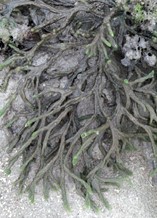
To better understand and assess the state of our marine biodiversity, NParks has embarked on a series of research projects in collaboration with different research institutions and interest groups to study, document and monitor our marine natural heritage.
The study on the biodiversity and distribution of the marine sponges (an animal that comes in various colours, shapes and sizes and is rooted to one spot, very much like a plant) of Singapore with NUS is one such example. These sponges play many important roles in the coral reef ecosystem such as serving as food and providing habitats for other marine organisms. They also possess potential chemical compounds that are of interest to pharmaceutical companies. The study has recorded over 100 species of inter-tidal sponges so far, of which more than 40 are new records for Singapore, and at least one is new to science. The project is now in its second phase, targeting sub-tidal species.
Another research programme that the Royal Belgian Institute of Natural Sciences, NUS and NParks are currently working on is the Singapore Mangrove Insect Project. Eleven mangrove sites in Singapore were surveyed during a one-month sampling campaign in May 2009 to document the richness of species and assess the quality of each site. The insect fauna of Singapore was found to be surprisingly diverse. During the one-month sampling, at least 10 new fly species were found, demonstrating that even in a densely populated country like Singapore, such ecological treasures can still be found.
Strategy 4: Enhance education and public awareness
Knowledge and awareness are pre-requisites for action, hence communication on biodiversity issues, are critical in driving public involvement. Effective communication will create greater awareness, interest in our natural heritage and instil a sense of national pride.
Actions:
- Increase appreciation, awareness and understanding of Singaporeans for nature through public seminars, road shows and events
- Promote volunteerism through biodiversity interest groups
- Incorporate elements of biodiversity conservation into the curricula of all levels of education
Volunteer and Outreach Programmes
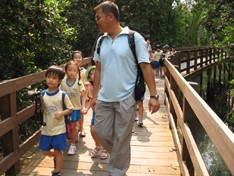
A variety of programmes are available for anyone wanting to be involved in nature conservation. This includes volunteering as guides at our nature areas, participating in habitat monitoring and giving a hand in reforestation projects.
Guided walks are available in places such as Sungei Buloh Wetland Reserve Central Natural Reserve, Pulau Ubin Recreational Area, Kusu Island, and Pulau Semakau. These tours are run by NParks and various interest groups including The Blue Water Volunteers, Raffles Museum of Biodiversity Research and Nature Society of Singapore.
Those who prefer to get their hands dirty can volunteer to remove debris from our shoreline. The International Coastal Cleanup Singapore, which is coordinated by the Toddycats (volunteers of the Raffles Museum of Biodiversity Research), is one of Singapore’s largest environmental conservation programmes with an average annual participation of 1,500 volunteers.
The public can also participate in biodiversity-related seminars and educational workshops conducted by organisations and interest groups such as NParks, Nature Society of Singapore, Cicada Tree Eco-place and The Leafmonkey Workshop. These varied organisations also reach out to the community by showcasing their work in environment-related events, such as Earth Day, International Day for Biological Diversity, World Environment Day, and Envirofest.
Wild Singapore Online!
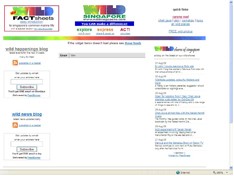
The “Wild Singapore” website (http://www.wildsingapore.com) was created by Ria Tan, a nature enthusiast, to provide a one-stop resource portal for Singaporeans who want to learn more about our nature areas and do more for them. The website features news on biodiversity and environmental issues, and provides a listing of nature-related events in Singapore. Fact sheets for visitors on Singapore's nature areas are available, along with a listing of volunteer opportunities and other ways to make a difference for nature in Singapore. Nearly 7,000 photos of Singapore's wildlife are also available for free download. Singapore's marine biodiversity and related-issues form the focus of the affiliated “Wild Shores of Singapore” blog (http://wildshores.blogspot.com). Since it went online in 2007, the “Wild Singapore” website has attracted nearly 800,000 visitors, with 2,000 to 15,000 unique visitors each month.
In recent years, more Singaporeans are blogging about nature and environmental issues, a sign of growing awareness of nature conservation. This trend not only allows ordinary Singaporeans to take a deeper interest in our natural heritage, but also builds a community of people who care about and act on these issues.
SUN Club: Special Projects to Understand Nature
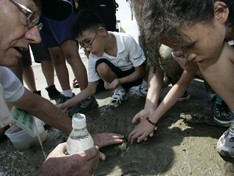
The SUN Club programme is founded on the idea of ‘nature for everyone’. It aims to bring nature appreciation to students with special needs through tailor-made projects developed in consultation with special schools.
Initiated by NParks and launched in October 2006, the SUN Club programme is supported by a sponsorship from Singapore Press Holdings Foundation (SPH Foundation). It is a community partnership project that also involves the National Council of Social Service (NCSS) and five special schools that pioneered the programme with NParks.
SUN Club participants get to visit some of Singapore's most fascinating nature areas with trained guides: the Sungei Buloh Wetland Reserve, Bukit Timah Nature Reserve, Pulau Ubin, Pasir Ris Park and East Coast Park. They will bring home fond memories of Singapore's biodiversity, and gain an understanding of how theyare a critical link in the web of life.
Strategy 5: Strengthen partnerships with all stakeholders and promote international collaboration
The most effective mode of operation for biodiversity conservation is to engage all stakeholders, including private, public and people sectors (government agencies, academia, schools, conservation groups, amateur naturalists and private corporations), in a comprehensive partnership.
Such partnerships should be pursued domestically and internationally as biodiversity issues cut across sectors and transcend national boundaries.
Actions:
- Encourage active participation in the stewardship of the environment for all sectors
- Promote partnerships with regional and international organisations, in particular the ASEAN Centre for Biodiversity and the Secretariat of the Convention on Biological Diversity, as an indication of our commitment to biodiversity conservation at the global level
TeamSeaGrass
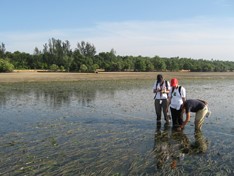
Seagrasses are flowering plants that live underwater and they play an essential role in the marine environment, being a nursery, food source and habitat to a variety of marine animals. Seagrasses also act as sentinels of coastal change and, with regular monitoring, can provide early warnings changes in the coastal environment.
Len McKenzie and Rudi Yoshida from Seagrass-Watch HQ (the largest scientific, non-destructive, seagrass assessment and monitoring programme in the world) witnessed for themselves a delightful spread of seagrass species when they visited Chek Jawa on Pulau Ubin with nature enthusiasts, Ria Tan and Siti Maryam Yaakub, on 8 October 2006. Their visit started the ball rolling for Seagrass-Watch here in Singapore and sparked off a strong partnership between Ria, Siti and National Parks Board as well as the catchy name "TeamSeaGrass".
Since it begun in November 2006, TeamSeaGrass, a volunteer-based seagrass monitoring programme, grew from strength to strength, both in volunteer numbers as well as the relationships fostered between various groups of people working towards a common vision and aspiration for the natural environment. NParks plays a vital role in this 3P (People-Public-Private sectors) project by working closely with the people, school students and private organisations, creating a synergistic collaboration for nature conservation.
An enthusiastic team of volunteers monitors the seagrass meadows at Chek Jawa, Pulau Semakau, Cyrene Reef and Tanjong Rimau on Sentosa once every three months. Schering-Plough, a pharmaceutical company based at Tuas runs the monitoring programme at the site adjacent to its premises as part of its Corporate Responsibility and Environmental Stewardship. TeamSeaGrass and NParks have also developed a partnership with Raffles Girls School to monitor the seagrass site at Labrador Nature Reserve and carry out scientific studies on seagrass as part of the school’s science research programme.
Singapore Index on Cities’ Biodiversity
In 2008, more than half of the world’s population lived in cities. Global demographic trends indicate that there will be more cities emerging and the number of megacities will increase. However, biodiversity, which is important for sustaining human health, is disappearing at an unprecedented rate. The key to the success of biodiversity conservation, hence, lies in the hands of city dwellers. However, we cannot act appropriately unless we know where we stand in terms of our biodiversity conservation status.
As a city-state, Singapore, with its rich legacy of biodiversity, is in an advantageous position to develop an innovative way to address this global issue. In May 2008, Singapore proposed the establishment of an index to measure biodiversity in cities at the 9th Meeting of the Conference of the Parties to the Convention on Biological Diversity.
Seventeen technical experts, comprising representatives from the Global Partnership on Cities and Biodiversity, convened at a workshop in Singapore in February 2009, to design the Singapore Index on Cities’ Biodiversity.
The Singapore Index comprises three components:
a) Biodiversity in the City
b) Ecosystem Services provided by the Native Biodiversity in the City
c) Governance and Management of Biodiversity in the City. In this form, it would function as a monitoring tool.
The global responses from city officials, scientists, conservation managers, academics, etc. have been positive, and various cities are now testing out the draft index to validate its usefulness. The Users’ Manual for the Singapore Index on Cities’ Biodiversity is posted on the website of the Convention on Biological Diversity (http://www.cbd.int/doc/groups/cities/cities-draft-user-manual-singapore-index-2009-07-01-en.pdf)
ASEAN Centre for Biodiversity
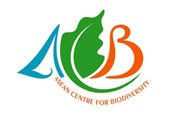
The ASEAN Centre for Biodiversity (ACB) is an inter-governmental regional centre of excellence, which facilitates cooperation among members of the Association of Southeast Asian Nations (ASEAN) and its partners for the conservation and sustainable use of biological diversity and fair sharing of benefits arising from such use.
Singapore, a member of the Governing Board of the Centre, contributes to the Centre in terms of co-organising and hosting activities with the ACB, for example, the Asia-Pacific Regional Consultation and Capacity-building Workshop on REDD+ in Developing Countries, including on Relevant Biodiversity Safeguards in March 2011 and ASEAN Workshop on the Singapore Index on Cities' Biodiversity in Jun 2014.Singapore benefits from the sharing of information, experiences and best practices among its members and in particular capacity building activities. These programmes include the development of biodiversity indicators conducted by the ACB with the support of regional and international partners such as the Secretariat of the Convention on Biological Diversity and World Conservation Monitoring Centre.
For more information, visit www.aseanbiodiversity.org